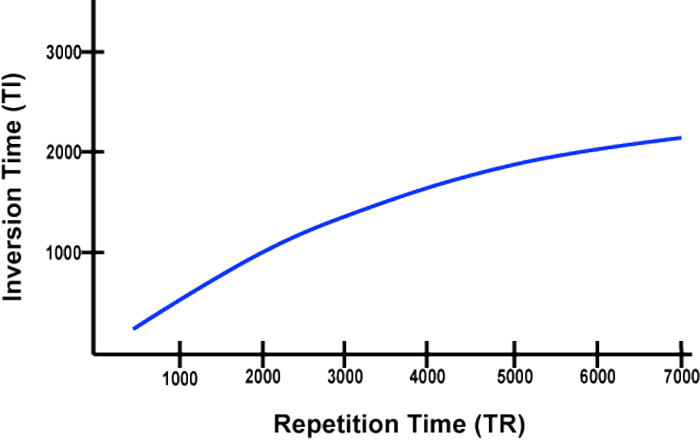T1-FLAIR stands for T1-weighted-Fluid-Attenuated Inversion Recovery. This nomenclature began to arise in the late 1990s to denote an inversion recovery sequence with dark CSF and other T1-like properties made possible by a medium TI coupled with fast spin-echo signal acquisition. In reality, this was pretty much the standard IR technique that had been used for years, just tuned up and rebranded for the modern era.
For an IR pulse sequence using fast spin-echo acquisition, signal intensity is nulled when TI is chosen so that the term
Because CSF has a long intrinsic T1 value (3000-4000 ms), its TInull is strongly dependent on the TR selected. For T1-FLAIR both the TR and TE values are kept relatively short to minimize T2-weighting. Considering these restrictions, the TInull for a T1-FLAIR sequence is typically in the range of 800-1000 ms. The graph below shows the approximate relationship between TI and TR for fluid/CSF suppression.
Advanced Discussion (show/hide)»
No supplementary material yet. Check back soon!
References
Bydder GM, Young IR. MR imaging: clinical use of the inversion recovery sequence. J Comput Assist Tomogr 1985; 9:659-675.
Melhem ER, Israel DA, Eustace S, Jara H. MR of the spine with a fast T1-weighted fluid-attenuated inversion recovery sequence. AJNR Am J Neuroradiol 1997; 18:447-454.
Bydder GM, Young IR. MR imaging: clinical use of the inversion recovery sequence. J Comput Assist Tomogr 1985; 9:659-675.
Melhem ER, Israel DA, Eustace S, Jara H. MR of the spine with a fast T1-weighted fluid-attenuated inversion recovery sequence. AJNR Am J Neuroradiol 1997; 18:447-454.



